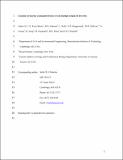Genomes of marine cyanopodoviruses reveal multiple origins of diversity
Author(s)
Labrie, Simon J.; Frois-Moniz, Katya; Osburne, Marcia; Kelly, Libusha; Roggensack, Sara; Sullivan, M. B.; Gearin, Gary; Zeng, Q.; Fitzgerald, M.; Henn, Matthew R.; Chisholm, Sallie (Penny); ... Show more Show less
DownloadPodo_comparative Final annotated MS.pdf (3.498Mb)
OPEN_ACCESS_POLICY
Open Access Policy
Creative Commons Attribution-Noncommercial-Share Alike
Terms of use
Metadata
Show full item recordAbstract
The marine cyanobacteria Prochlorococcus and Synechococcus are highly abundant in the global oceans, as are the cyanophage with which they co-evolve. While genomic analyses have been relatively extensive for cyanomyoviruses, only three cyanopodoviruses isolated on marine cyanobacteria have been sequenced. Here we present nine new cyanopodovirus genomes, and analyse them in the context of the broader group. The genomes range from 42.2 to 47.7 kb, with G+C contents consistent with those of their hosts. They share 12 core genes, and the pan-genome is not close to being fully sampled. The genomes contain three variable island regions, with the most hypervariable genes concentrated at one end of the genome. Concatenated core-gene phylogeny clusters all but one of the phage into three distinct groups (MPP-A and two discrete clades within MPP-B). The outlier, P-RSP2, has the smallest genome and lacks RNA polymerase, a hallmark of the Autographivirinae subfamily. The phage in group MPP-B contain photosynthesis and carbon metabolism associated genes, while group MPP-A and the outlier P-RSP2 do not, suggesting different constraints on their lytic cycles. Four of the phage encode integrases and three have a host integration signature. Metagenomic analyses reveal that cyanopodoviruses may be more abundant in the oceans than previously thought.
Date issued
2013-01Department
Massachusetts Institute of Technology. Department of Civil and Environmental EngineeringJournal
Environmental Microbiology
Publisher
Wiley Blackwell
Citation
Labrie, S. J. et al. “Genomes of Marine Cyanopodoviruses Reveal Multiple Origins of Diversity.” Environmental Microbiology 15.5 (2013): 1356–1376.
Version: Author's final manuscript
ISSN
1462-2912
1462-2920